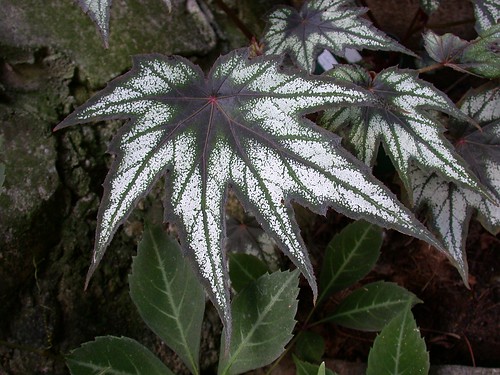
Begonia 'Little Brother Montgomery' is--almost literally--one of the stars of the fall garden. The starburst-shaped leaves have a strongly contrasting pattern of tiny bright silver speckles on a dark background. I was originally inspired to grow this striking begonia by Derick Pitman's excellent article in the Oct. 2009 Pacific Horticulture, "A Bounty of (Hardier) Begonias". In this article Derick reported that B. 'Connee Boswell'* had survived a hard freeze in a pot, and suggested that its sibling 'Little Brother Montgomery' might have some degree of hardiness as well. I was interested in breeding hardy begonias so that hint was all I needed! In spring 2010 I found 'Little Brother Montgomery' at Pepper's Greenhouses in Milton, DE and brought two small plants home with me. It has performed well for me in the years since then, has been an easy, pest- and disease-free plant and has even proven fairly hardy.
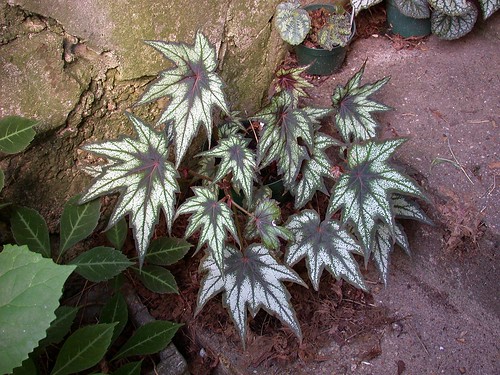
The distinctive "starburst" leaves of Begonia 'Little Brother Montgomery'
'Little Brother Montgomery' was first mentioned in The Begonian in 1993. Although never registered, it is reportedly a sibling of 'Connee Boswell', registered by begonia breeder Martin Johnson in 1985 from a cross originally made in 1979 with the parentage described as B. palmata var. palmata x B. diadema. Like several of Martin Johnson's hybrids (including 'Connee Boswell'), 'Little Brother Montgomery' was named after a jazz and blues musician, Eurreal Wilford "Little Brother" Montgomery (listen to a recording here).

Begonia 'Little Brother Montgomery' in the fall garden
I've tried 'Little Brother Montgomery' in various places around my garden and find that it performs best in rich, moist, well-drained soil in bright full shade. Direct sun for any extended period of time tends to scorch the leaves but it is reasonably heat-tolerant as long as it has sufficient shade and moisture. The foliage is surprisingly cold-tolerant and looks good right until a hard freeze knocks the plants down. At this point (or shortly before) they can be mulched with compost and/or autumn leaves. As long as the rhizomes don't freeze they will come back the next spring, generally on the late side (around the same time as the "hardy begonia" B. grandis, a notoriously late riser). As insurance, I take cuttings in the fall to propagate indoors over the winter; propagation is very easy from both leaf and stem cuttings.
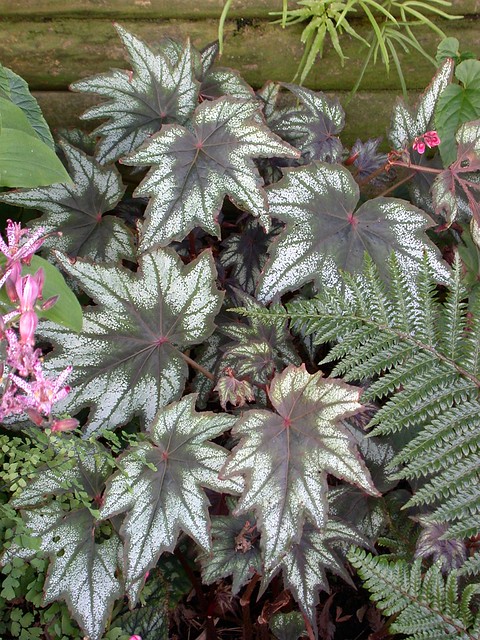
Begonia 'Little Brother Montgomery' with Tricyrtis and ferns
'Little Brother Montgomery' produces small, deep pink flowers but it has been a shy bloomer for me. Unlike some begonias that are grown primarily for their flowers, 'Little Brother Montgomery' is ornamental from the very start. It stands out in shade and contrasts well with plants that have bright green leaves; the fine foliage of maidenhair ferns provides an excellent foil. Other good companions in my garden have been hardy impatiens (Impatiens omeiana), toad lilies (Tricyrtis 'Sinonome'), and other begonias. It makes a nice specimen plant but looks even better planted in groups of 3 or more. In my garden it grows to around 12-18" but it can grow much larger with a longer growing season, or where it doesn't freeze to the ground. Its hardiness is still incompletely known; my own plants have survived 3 winters in the ground with only a light mulch, but recent winters in my region have been fairly mild with lows in the mid to high teens and no extended periods below freezing.
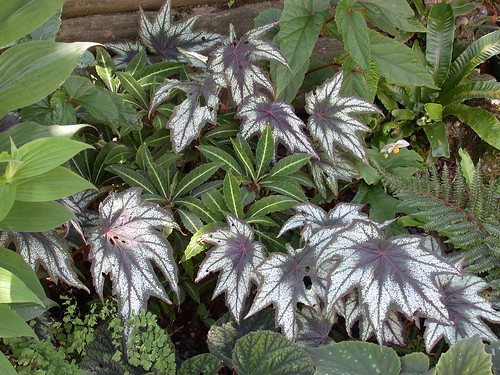
Begonia 'Little Brother Montgomery' in early June with Impatiens omeiana
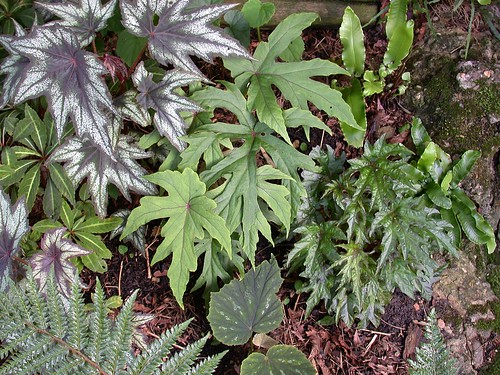
Begonia 'Little Brother Montgomery' with B. pedatifida and B. U614
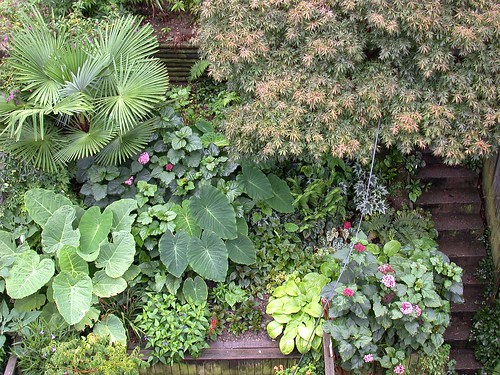
'Little Brother Montgomery' has a great visual impact even from a distance,
as seen in this view from my rooftop deck
'Little Brother Montgomery belongs to a group of begonias classified by the American Begonia Society as rhizomatous, "rhizome jointed at or below the soil with erect stems". In my experience, 'Little Brother Montgomery' doesn't really produce a rhizome; rather it produces tuber-like swollen underground stems, from which new growth emerges; the "rhizome" consists of the stem bases from previous years' growth.
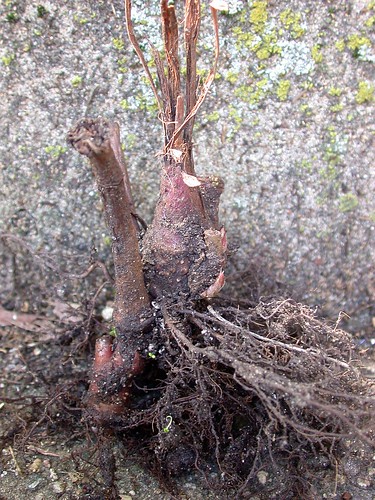
Underground "rhizome" of Begonia 'Little Brother Montgomery'
Sibling 'Connee Boswell' has even more beautiful leaves but is a more delicate plant that is more difficult to grow and less heat-tolerant; although I've had rather poor luck with this one a plant in my garden did return, albeit weakly and very late. Both begonias are reputed to be prone to mildew but I have had no trouble myself (or with any other mildew-prone begonias grown outdoors, for that matter).

Begonia 'Connee Boswell' (photo: American Begonia Society)
Both 'Connee Boswell' and 'Little Brother Montgomery' are fertile and have been crossed with each other and with other begonias to make numerous hybrids. Prolific begonia breeder Brad Thompson has produced a large number of cultivars with beautiful foliage like 'Janet Brown' and 'Mr. Hunt' (and all of these hybrids should be tested for hardiness!). I'm anxious to use 'Little Brother Montgomery' in some crosses of my own, but the buds tend to drop before opening and any flowers appear too late in the fall to accomplish any crosses before freezing. I got a single seedling from a cross with B. grandis; although the hybrid had beautiful leaves it was a weak grower and didn't survive its first winter in the ground. I hope to repeat this cross and (hopefully) get some more vigorous seedlings.
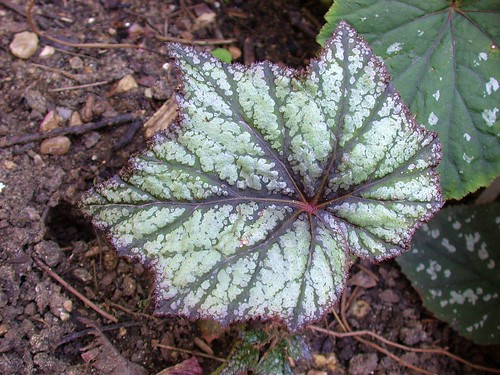
B. grandis 'Early Bird' x B. 'Little Brother Montgomery' (unnamed Boggan hybrid)
'Little Brother Montgomery' is available from Pepper's Greenhouses in Milton, DE, Taylor Greenhouses in Portland, NY and Annie's Annuals in Richmond, CA.
*In Derick Pitman's article, the photograph of 'Connee Boswell' (frequently mispelled "Connie Boswell") is mis-labeled as Begonia emeiensis.

No comments :
New comments are not allowed.